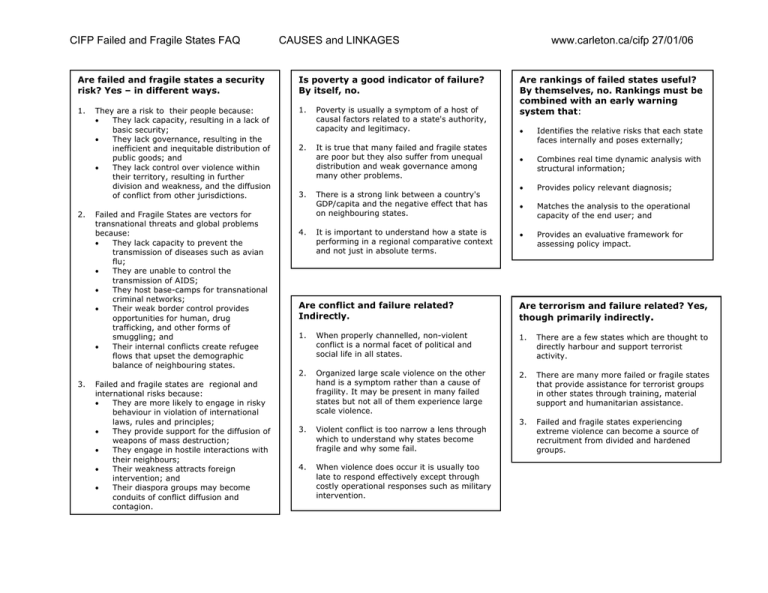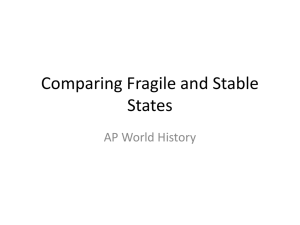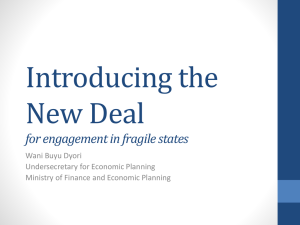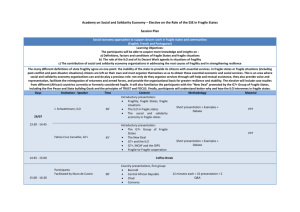CIFP Failed and Fragile States FAQ
advertisement

CIFP Failed and Fragile States FAQ CAUSES and LINKAGES Are failed and fragile states a security risk? Yes – in different ways. Is poverty a good indicator of failure? By itself, no. 1. 1. 2. 3. They are a risk to their people because: • They lack capacity, resulting in a lack of basic security; • They lack governance, resulting in the inefficient and inequitable distribution of public goods; and • They lack control over violence within their territory, resulting in further division and weakness, and the diffusion of conflict from other jurisdictions. Failed and Fragile States are vectors for transnational threats and global problems because: • They lack capacity to prevent the transmission of diseases such as avian flu; • They are unable to control the transmission of AIDS; • They host base-camps for transnational criminal networks; • Their weak border control provides opportunities for human, drug trafficking, and other forms of smuggling; and • Their internal conflicts create refugee flows that upset the demographic balance of neighbouring states. Failed and fragile states are regional and international risks because: • They are more likely to engage in risky behaviour in violation of international laws, rules and principles; • They provide support for the diffusion of weapons of mass destruction; • They engage in hostile interactions with their neighbours; • Their weakness attracts foreign intervention; and • Their diaspora groups may become conduits of conflict diffusion and contagion. 2. 3. 4. Poverty is usually a symptom of a host of causal factors related to a state's authority, capacity and legitimacy. It is true that many failed and fragile states are poor but they also suffer from unequal distribution and weak governance among many other problems. There is a strong link between a country's GDP/capita and the negative effect that has on neighbouring states. It is important to understand how a state is performing in a regional comparative context and not just in absolute terms. www.carleton.ca/cifp 27/01/06 Are rankings of failed states useful? By themselves, no. Rankings must be combined with an early warning system that: • Identifies the relative risks that each state faces internally and poses externally; • Combines real time dynamic analysis with structural information; • Provides policy relevant diagnosis; • Matches the analysis to the operational capacity of the end user; and • Provides an evaluative framework for assessing policy impact. Are conflict and failure related? Indirectly. Are terrorism and failure related? Yes, though primarily indirectly. 1. When properly channelled, non-violent conflict is a normal facet of political and social life in all states. 1. There are a few states which are thought to directly harbour and support terrorist activity. 2. Organized large scale violence on the other hand is a symptom rather than a cause of fragility. It may be present in many failed states but not all of them experience large scale violence. 2. There are many more failed or fragile states that provide assistance for terrorist groups in other states through training, material support and humanitarian assistance. 3. Violent conflict is too narrow a lens through which to understand why states become fragile and why some fail. 3. Failed and fragile states experiencing extreme violence can become a source of recruitment from divided and hardened groups. 4. When violence does occur it is usually too late to respond effectively except through costly operational responses such as military intervention. CIFP Failed and Fragile States FAQ How do we measure state failure and fragility? All risk is relative. • Indicators are useful for defining state failure only if there are appropriate reference cases from which to compare. • Failure and fragility are relative terms that have meaning only with respect to state performance at specific points. • A proper reference for understanding state failure and fragility is a state’s past, present and future performance in absolute terms and its performance relative to other states at any given point. Are watch lists and country briefs useful? Yes. • They can galvanize public opinion both at home and abroad. • They can provide an invaluable heads-up before situations turn violent. • They can identify priority areas of concern. ANALYSIS AND RESPONSE State Failure Lexicon Fragile states lack the functional authority to provide basic security within their borders, the institutional capacity to provide basic social needs for their populations, and/or the political legitimacy to effectively represent their citizens at home and abroad. Weak states are susceptible to fragility or failure because of limited governance capacity, economic stagnation, and/or an inability to ensure the security of their borders and sovereign domestic territory. Failing States exhibit key elements of fragility, and are experiencing organized political violence. Peace processes are weak or non-existent. Failed States States characterized by conflict, humanitarian crises, and economic collapse. Government authority, legitimacy, and capacity no longer extend throughout the state, but instead are limited either to specific regions or groups. Collapsed States possess no meaningful central governments. These nations exist purely as geographical expressions, lacking any characteristics of state authority, legitimacy, or capacity. Recovering States States that exhibit key elements of fragility, but where substantial and at least partially successful “nation building” efforts are present. www.carleton.ca/cifp 27/01/06 Is lack of political will the real issue? No. The reasons behind inaction in situations of state fragility and failure 1. The traditional governmental separation between analysis/intelligence and policy/ operations; 2. The difficulty in planning multi-sectoral responses to problems with such complex causes; 3. The tendency for immediate crises to crowd out strategic consideration of future issues and potential problems; 4. The lack of a structured model for systematic, rather than ad hoc, early warning and risk analysis; 5. Deficiencies in the manner in which warnings are transmitted to decision-makers, and 6. The difficulty in deriving assessments of the operational implications of such warnings.



